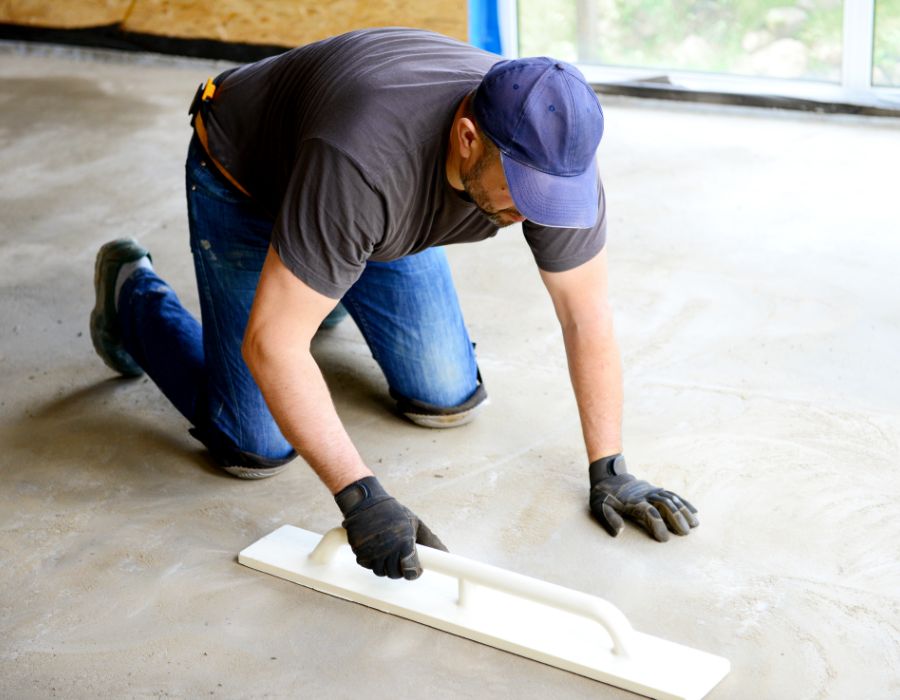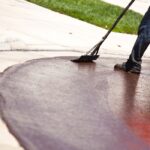When it comes to flooring solutions for San Antonio homes, concrete offers a versatile and durable option that is both stylish and practical. With a variety of finishes, including stamped, stained, and epoxy coatings, with concrete flooring options for San Antonio homes, homeowners are assured of a solution tailored to both indoor and outdoor spaces. These concrete flooring options are particularly suitable for the city’s climate, offering long-lasting and low-maintenance benefits. Let’s explore the differences between these popular finishes and how they compare in terms of aesthetics, durability, and maintenance.
Comparing Stamped, Stained, and Epoxy Concrete
- Stamped Concrete
Stamped concrete is a decorative technique where patterns and textures are imprinted on freshly poured concrete. It’s designed to resemble materials like brick, slate, flagstone, and wood, offering the look of more expensive materials without the cost. This finish is ideal for patios, driveways, and pool decks, where the aesthetic appeal of outdoor concrete designs is essential.
- Advantages of Stamped Concrete
When comparing stamped, stained, and epoxy concrete, one of the main advantages of stamped concrete over traditional paving materials is its customizability. These concrete flooring options for San Antonio homes allow homeowners to choose from a wide range of colors and patterns, creating a unique, customizable concrete finish that complements the style of their home. Stamped concrete is weather-resistant and can withstand San Antonio’s hot summers without cracking or fading. This makes one of the best weather-resistant concrete treatments for outdoor spaces.
Stamped concrete also provides a seamless surface, making it easier to maintain than individual pavers that may shift or allow weeds to grow between them. However, it does require sealing to maintain its color and protect it from moisture and harsh weather conditions.
- Stained Concrete
Stained concrete offers a more subtle yet sophisticated look when comparing stamped, stained, and epoxy concrete. This technique uses acid-based or water-based stains to penetrate the concrete, creating a rich, variegated color effect. Stained concrete is commonly used for indoor concrete flooring, such as in living rooms, kitchens, and bathrooms, but it can also be applied to outdoor spaces like patios.
Why Choose Stained Concrete?
Stained concrete is an excellent choice for homeowners looking for a cost-effective flooring solution that still offers a luxurious appearance. The range of available colors, from earthy tones to bold hues, makes it one of the popular concrete flooring options for San Antonio homes for those wanting to create unique, designs using decorative concrete techniques. Additionally, it’s durable and resistant to fading, especially when sealed properly.
For indoor use, stained concrete floors are easy to clean and hypoallergenic, making them perfect for homes with pets or family members with allergies. In outdoor settings, a stained concrete patio can complement the natural surroundings of San Antonio homes while providing a low-maintenance flooring solution.
Epoxy Coated Concrete
Upon comparing stamped, stained, and epoxy concrete, we learn that epoxy flooring is often used for garage floor durability, but it’s also becoming increasingly popular in residential interiors due to its high-performance finish. Epoxy is a two-part coating that, when applied to concrete, creates a strong, glossy surface resistant to stains, chemicals, and wear.
Benefits of Epoxy Garage Floors in San Antonio
In San Antonio, where garages often serve as more than just a place to park cars—think of workshops or home gyms—an epoxy garage floor offers several advantages. First, it’s resistant to oil spills, tire marks, and moisture, making it ideal for garage spaces. Additionally, epoxy coatings are durable enough to withstand the heat and humidity of San Antonio’s climate without peeling or cracking. On average, an epoxy floor can last 10-20 years with proper care, but its lifespan may vary depending on the quality of the installation and the level of foot and vehicle traffic it endures.
The long-term concrete floor benefits with epoxy coatings extend beyond just garages. For homeowners looking to transform basements or even kitchens into sleek, industrial spaces, these concrete flooring options for San Antonio homes offer a modern, glossy look that enhances any room’s aesthetic.
Indoor vs. Outdoor Concrete Flooring: Which is Better?
When deciding between concrete flooring for indoor or outdoor applications, it’s essential to weigh the concrete vs. traditional flooring debate. Traditional flooring materials, such as hardwood, tile, or carpet, are prone to wear and tear, especially in areas with high foot traffic or exposure to moisture. Concrete, on the other hand, is highly durable and can last for decades with minimal maintenance.
For indoor concrete flooring, stained and epoxy finishes offer stylish yet durable options that are easy to maintain. Indoor concrete floors are especially suited for modern, minimalist homes but can be customized to fit a wide range of design aesthetics.
In outdoor spaces, stamped concrete is often the go-to choice due to its ability to mimic natural stone or brick, giving patios, driveways, and walkways a high-end look at a fraction of the cost. Outdoor concrete designs can also incorporate various decorative techniques, such as exposed aggregate or colored concrete, to create a distinctive, long-lasting surface.
Concrete Maintenance Tips
While concrete is durable, it still requires some level of upkeep to maintain its appearance and longevity. Here are a few concrete maintenance tips to keep in mind:
- Sealing: Whether you have stamped, stained, or epoxy-coated concrete, regular sealing is essential. A good quality sealer helps protect against moisture, stains, and wear.
- Cleaning: For indoor concrete floors, regular sweeping and mopping with a pH-neutral cleaner will keep the surface looking fresh. Outdoor concrete surfaces should be hosed down periodically to remove dirt and debris.
- Repairing Cracks: Small cracks can appear over time, especially in outdoor concrete exposed to temperature changes. Filling these cracks with a concrete patch can prevent further damage.
- Re-sealing: For stamped and stained concrete, re-sealing every 2-3 years helps preserve the color and protect the surface from the elements.
Cost-Effective Flooring Solutions
One of the key reasons why concrete flooring is so popular in San Antonio is its affordability. Compared to traditional materials like wood, tile, or stone, concrete is much more cost-effective both in terms of initial installation and long-term maintenance. Stamped and stained concrete provide homeowners with elegant, customizable concrete finishes without breaking the bank, while epoxy coatings offer unmatched durability at a competitive price point.
Conclusion: Choosing the Right Concrete Flooring Option
Comparing stamped, stained, and epoxy concrete and choosing the right one from the many concrete flooring options for San Antonio homes ultimately depends on the intended use of the space and personal design preferences. For outdoor areas, stamped concrete is an excellent choice due to its decorative appeal and weather resistance. Stained concrete is perfect for creating unique indoor spaces with a warm, sophisticated look. Epoxy-coated concrete, with its industrial strength and sleek appearance, is ideal for garages and modern interiors.
Regardless of the finish you choose, concrete offers numerous benefits, including durability, low maintenance, and versatility, making it a great choice for any home in San Antonio.
FAQs
Q: What are the advantages of stamped concrete over traditional paving materials?
A: Stamped concrete is more cost-effective, customizable, and weather-resistant compared to traditional paving materials like brick or stone. It offers a seamless finish and requires less maintenance.
Q: How long does an epoxy garage floor coating typically last in San Antonio’s climate?
A: An epoxy garage floor coating can last anywhere from 10-20 years in San Antonio’s climate, depending on the quality of the installation and the level of traffic it endures. Regular maintenance can extend its lifespan.







